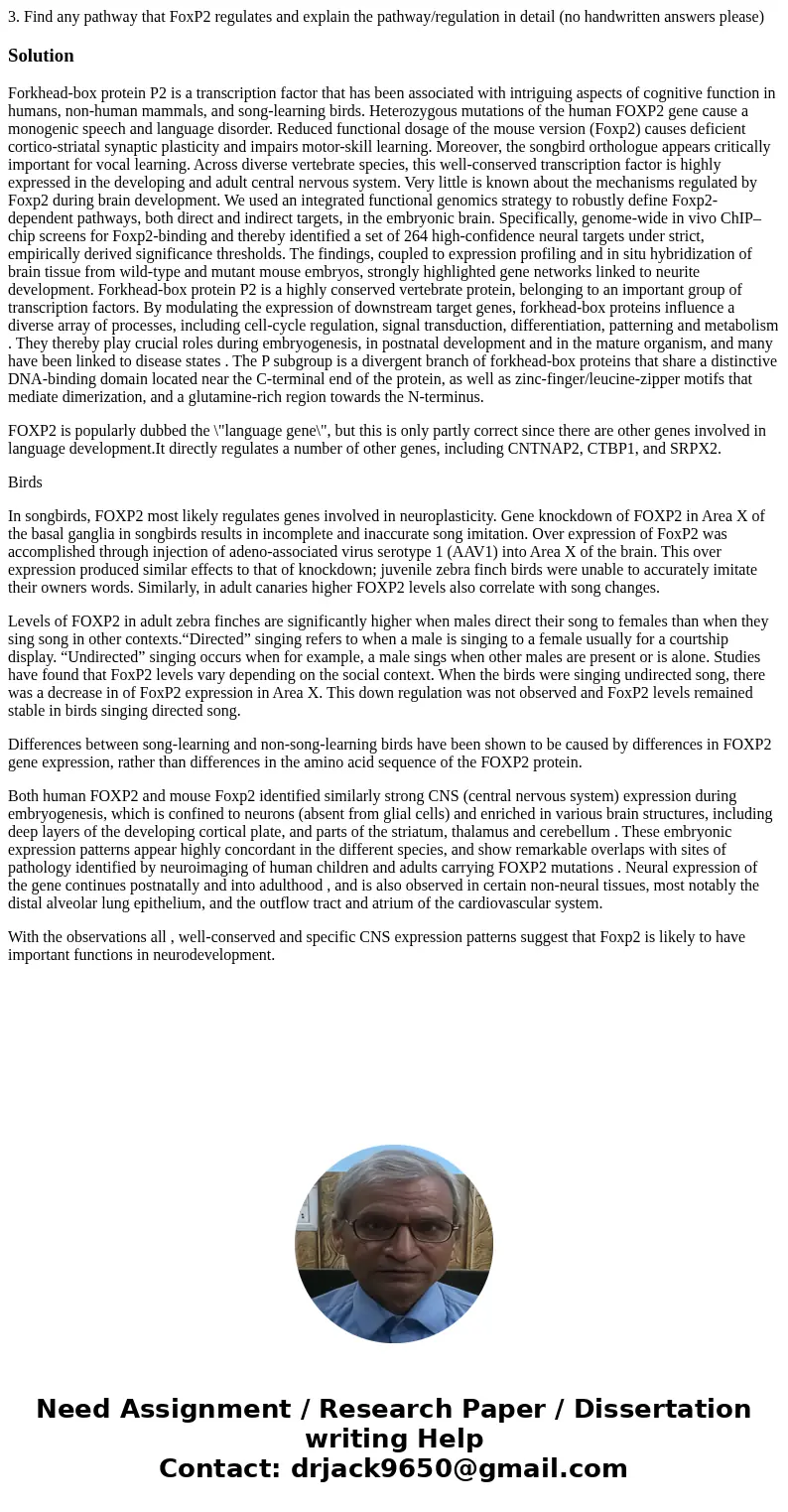3 Find any pathway that FoxP2 regulates and explain the path
3. Find any pathway that FoxP2 regulates and explain the pathway/regulation in detail (no handwritten answers please)
Solution
Forkhead-box protein P2 is a transcription factor that has been associated with intriguing aspects of cognitive function in humans, non-human mammals, and song-learning birds. Heterozygous mutations of the human FOXP2 gene cause a monogenic speech and language disorder. Reduced functional dosage of the mouse version (Foxp2) causes deficient cortico-striatal synaptic plasticity and impairs motor-skill learning. Moreover, the songbird orthologue appears critically important for vocal learning. Across diverse vertebrate species, this well-conserved transcription factor is highly expressed in the developing and adult central nervous system. Very little is known about the mechanisms regulated by Foxp2 during brain development. We used an integrated functional genomics strategy to robustly define Foxp2-dependent pathways, both direct and indirect targets, in the embryonic brain. Specifically, genome-wide in vivo ChIP–chip screens for Foxp2-binding and thereby identified a set of 264 high-confidence neural targets under strict, empirically derived significance thresholds. The findings, coupled to expression profiling and in situ hybridization of brain tissue from wild-type and mutant mouse embryos, strongly highlighted gene networks linked to neurite development. Forkhead-box protein P2 is a highly conserved vertebrate protein, belonging to an important group of transcription factors. By modulating the expression of downstream target genes, forkhead-box proteins influence a diverse array of processes, including cell-cycle regulation, signal transduction, differentiation, patterning and metabolism . They thereby play crucial roles during embryogenesis, in postnatal development and in the mature organism, and many have been linked to disease states . The P subgroup is a divergent branch of forkhead-box proteins that share a distinctive DNA-binding domain located near the C-terminal end of the protein, as well as zinc-finger/leucine-zipper motifs that mediate dimerization, and a glutamine-rich region towards the N-terminus.
FOXP2 is popularly dubbed the \"language gene\", but this is only partly correct since there are other genes involved in language development.It directly regulates a number of other genes, including CNTNAP2, CTBP1, and SRPX2.
Birds
In songbirds, FOXP2 most likely regulates genes involved in neuroplasticity. Gene knockdown of FOXP2 in Area X of the basal ganglia in songbirds results in incomplete and inaccurate song imitation. Over expression of FoxP2 was accomplished through injection of adeno-associated virus serotype 1 (AAV1) into Area X of the brain. This over expression produced similar effects to that of knockdown; juvenile zebra finch birds were unable to accurately imitate their owners words. Similarly, in adult canaries higher FOXP2 levels also correlate with song changes.
Levels of FOXP2 in adult zebra finches are significantly higher when males direct their song to females than when they sing song in other contexts.“Directed” singing refers to when a male is singing to a female usually for a courtship display. “Undirected” singing occurs when for example, a male sings when other males are present or is alone. Studies have found that FoxP2 levels vary depending on the social context. When the birds were singing undirected song, there was a decrease in of FoxP2 expression in Area X. This down regulation was not observed and FoxP2 levels remained stable in birds singing directed song.
Differences between song-learning and non-song-learning birds have been shown to be caused by differences in FOXP2 gene expression, rather than differences in the amino acid sequence of the FOXP2 protein.
Both human FOXP2 and mouse Foxp2 identified similarly strong CNS (central nervous system) expression during embryogenesis, which is confined to neurons (absent from glial cells) and enriched in various brain structures, including deep layers of the developing cortical plate, and parts of the striatum, thalamus and cerebellum . These embryonic expression patterns appear highly concordant in the different species, and show remarkable overlaps with sites of pathology identified by neuroimaging of human children and adults carrying FOXP2 mutations . Neural expression of the gene continues postnatally and into adulthood , and is also observed in certain non-neural tissues, most notably the distal alveolar lung epithelium, and the outflow tract and atrium of the cardiovascular system.
With the observations all , well-conserved and specific CNS expression patterns suggest that Foxp2 is likely to have important functions in neurodevelopment.

 Homework Sourse
Homework Sourse